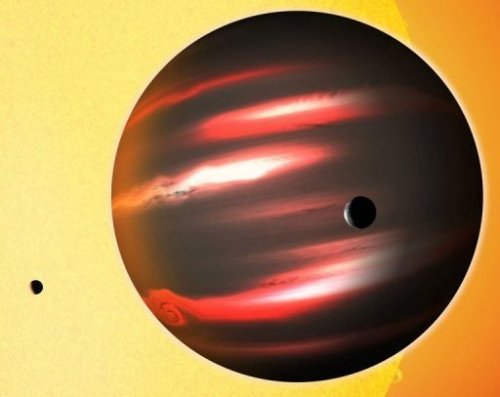PARIS (AFP) -- A planet orbiting a distant star is darker than coal, reflecting less than one percent of the sunlight falling on it, according to a paper published on Thursday.
The strange world, TrES-2b, is a gas giant the size of Jupiter, rather than a solid, rocky body like Earth or Mars, astronomers said.

It closely orbits the star GSC 03549-02811, located about 750 light years away in the direction of the constellation of Draco the Dragon.
"TrES-2b is considerably less reflective than black acrylic paint, so it's truly an alien world," David Kipping of the Harvard-Smithsonian Center for Astrophysics said in a press release issued by Britain's Royal Astronomical Society (RAS).
First spotted five years ago, TrES-2b races around its star at a distance of just five million kilometres (three million miles).
This is scorchingly close when compared to Earth's 150-million-km
(93-million-mile) distance from the Sun and Jupiter's 778 million kms (483 million miles).
So fierce is the heat that the exoplanet's atmosphere is cooked to more than 1,000 degrees Celsius (1,800 degrees Fahrenheit).
Signatures from its atmosphere point to the presence of light-absorbing chemicals like vaporised sodium and potassium or titanium oxide.
But none of these substances can explain the planet's darkness, which is more extreme than any planet or moon in our own Solar System.
"It's not clear what is responsible for making this planet so extraordinarily dark," said David Spiegel of Princeton University.
"However, it's not completely pitch black. It's so hot that it emits a faint red glow, much like a burning ember or the coils on an electric stove."
More than 500 extrasolar planets have been identified since 1995.
TrES-2b, like our Moon, is believed to be locked by gravitational tide, presenting only one face to its star.
The study, published in the RAS journal Monthly Notices, used NASA's orbiting Kepler spacecraft to make the observations.
<한글기사>
칠흑같이 캄캄한 외부행성 발견
지구로부터 750광년 거리에 있는 용(龍)자리의 행성이 지금까지 발견된 어떤 행성이나 위성보다도 어둡고 석탄보다도 더 새카맣게 보이는 것으로 밝혀졌다고 사이언스 데일리가 14일 보도했다.
미국 과학자들은 외부행성 추적 망원경 네트워크 TrES(Trans-Atlantic Exoplane t Survey)가 지난 2006년 발견한 TrES-2b을 관찰한 미항공우주국(NASA) 케플러 우주 망원경의 자료를 분석한 결과 이 행성이 반사하는 햇빛의 양이 1%도 안 된다는 사실을 발견했다고 영국 천문학회 월보에 발표했다.
연구진은 목성 크기의 가스 행성인 TrES의 반사율은 검은 아크릴 페인트보다도 낮다면서 "이는 정말로 낯선 세계"라고 밝혔다.
우리 태양계에 속한 목성은 밝은 암모니아 구름으로 둘러싸여 햇빛의 3분의1 이 상을 반사하지만 TrES-2b는 500만㎞에 불과한 중심별 GSC 03549-02811과의 가까운 거리 때문에 온도가 1천℃가 넘어 이런 구름이 형성되지 않는 것으로 밝혀졌다.
이 행성은 그 대신 증발한 나트륨과 칼륨, 또는 기화된 산화티타늄 등 빛을 흡수하는 화학성분 대기를 갖고 있다.
연구진은 "이 행성이 이처럼 예외적으로 어두운 이유가 확실히 밝혀진 것은 아니며 빛이 전혀 없는 것도 아니다. 고온 때문에 마치 잉걸불이나 달궈진 전기 곤로 의 코일처럼 희미한 붉은 빛을 내고 있다"고 설명했다.
이들은 케플러 망원경으로 중심별의 미세한 밝기 변화를 추적해 이 행성의 밝기 를 계산해냈다.
TrES는 우리 달처럼 중심별의 기조력에 갇혀 있어 항상 같은 쪽이 중심별을 향 하지만 궤도를 돌면서 노출면이 단계적으로 바뀌어 중심별과 행성을 합한 밝기에 미 세한 변화가 일어난다.
연구진은 이 행성이 중심별을 50차례 도는 과정을 조사한 결과 밝기에 100만분 의 6라는 믿을 수 없을 만큼 작은 변화가 생기는 것을 확인했다.
이들은 지금까지 1천200여 개의 외부행성 후보들을 찾아낸 케플러 망원경의 자료를 추가 분석하면 이처럼 어두운 행성이 또 있을지를 알 수 있을 것이라고 말했다. (연합뉴스)


















![[Today’s K-pop] BTS pop-up event to come to Seoul](http://res.heraldm.com/phpwas/restmb_idxmake.php?idx=642&simg=/content/image/2024/04/17/20240417050734_0.jpg&u=)